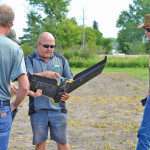Far more complex than yesterday’s remote-control planes, the modern-day drone has a lot to offer today’s producer. “As far as data collection, these are really useful. We are figuring that we can make use of them for a number of things, including determining crop health and monitoring maturity,” said Jeffery Kostuik, diversification specialist with Parkland









